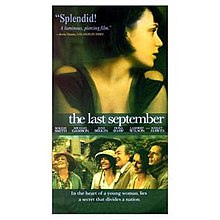The Last September

First edition
|
|
| Author | Elizabeth Bowen |
|---|---|
| Country | Ireland |
| Language | English |
| Publisher | Constable & Co Ltd |
|
Publication date
|
1929 |
| Media type | Print (hardback & paperback) |
| Preceded by | The Hotel (1927) |
| Followed by | Friends and Relations ( 1931) |
| The Last September | |
|---|---|

DVD cover
|
|
| Directed by | Deborah Warner |
| Written by |
John Banville Elizabeth Bowen (novel) |
| Starring |
Maggie Smith Michael Gambon Keeley Hawes David Tennant Lambert Wilson |
| Music by | Zbigniew Preisner |
| Cinematography | Slawomir Idziak |
| Edited by | Kate Evans |
| Distributed by |
Trimark Pictures UGC DA International |
|
Release date
|
|
|
Running time
|
103 minutes |
| Country | France United Kingdom Ireland |
| Language | English |
The Last September is a novel by the Irish writer Elizabeth Bowen published in 1929, concerning life at the country mansion of Danielstown, Cork during the Irish War of Independence.
Although The Last September was first published in 1929, a preface was written for this text decades later to be included in the second American edition of this novel. Concerned that readers unfamiliar with this particular chapter of Irish history would not fully comprehend the anxieties of these times, Bowen takes great pains to explain the particulars of both her writing process and the political reasons for the unsettled atmosphere felt throughout the text, palpable even in its most seemingly serene moments. Of all her books, Bowen notes, The Last September is "nearest to my heart, [and it] had a deep, unclouded, spontaneous source. Though not poetic, it brims up with what could be the stuff of poetry, the sensations of youth. It is a work of instinct rather than knowledge—to a degree, a ‘recall’ book, but there had been no such recall before.” While Bowen's own beloved family home, Bowen's Court, remained untouched throughout "The Troubled Times" this preface explores the ramifications for witnesses of “Ambushes, arrests, captures and burning, reprisals and counter-reprisals” as "The British patrolled and hunted; the Irish planned, lay in wait, and struck.” "I was the child of the house from which Danielstown derives" Bowen concludes, “nevertheless, so often in my mind's eye did I see it [Bowen’s Court] burning that the terrible last event in The Last September is more real than anything I have lived through.”
The Last September opens in “a moment of happiness, of perfection” as Sir Richard and Lady Naylor welcome their long-awaited guests, Hugo and Francie Montmorency, to their country estate, Danielstown, in Cork, Ireland. Despite—or, in some characters’ cases, in spite of—the tensions produced by what Bowen obliquely refers to as “The Troubled Times,” the Montmorencys, the Naylors, as well as the Naylors’ niece, Lois, and nephew, Laurence, attempt to live their lives in the aftermath of The Great War while coping with the occasionally conflicting dictates of their class's expectations and personal desires. Preoccupied with the concerns of social obligations which must be met even as they are enacted against a backdrop of uncertainty and national unrest, the residents of Danielstown occupy themselves with tennis parties, visits, and dances, often including the wives and officers of the British Army who have been assigned to this region. The people of Danielstown all share a particular interest in the shifting relationship between Lois and a young British officer, Gerald Lesworth, as Lois struggles to determine precisely who she is and what it is she wants out of life.
...
Wikipedia
